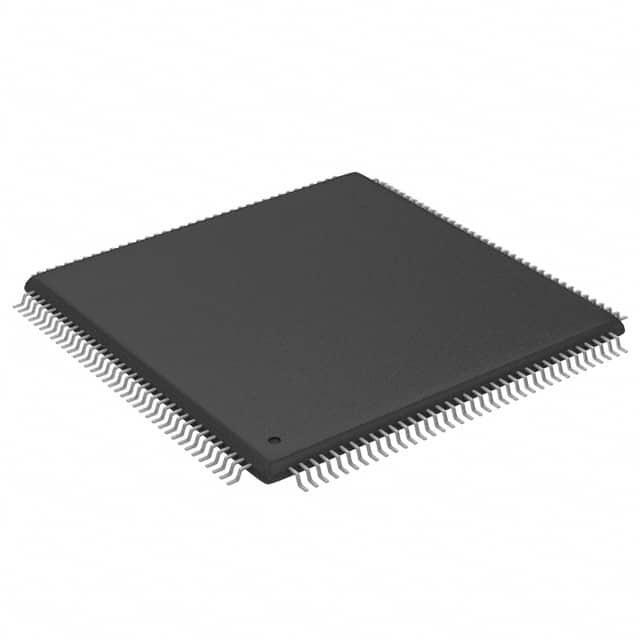XC2C128-6TQ144C
Product Overview
Category
XC2C128-6TQ144C belongs to the category of programmable logic devices (PLDs).
Use
This product is used for digital circuit design and implementation. It provides a flexible and customizable solution for various applications.
Characteristics
- Programmable: The XC2C128-6TQ144C can be programmed to perform specific functions based on user requirements.
- High-density: It offers a large number of configurable logic blocks, allowing for complex designs.
- Low power consumption: The device is designed to operate efficiently with minimal power consumption.
- Fast performance: The XC2C128-6TQ144C offers high-speed operation, enabling quick execution of digital circuits.
Package
The XC2C128-6TQ144C comes in a TQFP (Thin Quad Flat Pack) package.
Essence
The essence of XC2C128-6TQ144C lies in its ability to provide a reconfigurable hardware platform for implementing digital logic circuits.
Packaging/Quantity
This product is typically packaged in reels or trays, containing a specified quantity of XC2C128-6TQ144C devices.
Specifications
- Device type: Programmable Logic Device (PLD)
- Family: XC2C
- Density: 128 macrocells
- Speed grade: 6
- Package type: TQFP
- Package pins: 144
- Operating voltage: 3.3V
- I/O standards: LVTTL, LVCMOS
Detailed Pin Configuration
The XC2C128-6TQ144C has 144 pins, each serving a specific purpose in the device's functionality. The pin configuration is as follows:
(Pin Number) - (Pin Name) - (Function)
1 - VCCIO0 - I/O Power Supply 2 - GND - Ground 3 - IOB0 - Bidirectional I/O Pin 4 - IOB1 - Bidirectional I/O Pin 5 - IOB2 - Bidirectional I/O Pin ... 144 - VCCINT - Internal Power Supply
Functional Features
- Reconfigurability: The XC2C128-6TQ144C can be reprogrammed multiple times, allowing for design changes and updates.
- In-system programming: The device supports in-system programming, enabling easy configuration without the need for physical replacement.
- JTAG interface: It features a JTAG (Joint Test Action Group) interface for programming and debugging purposes.
- Embedded memory: The XC2C128-6TQ144C includes embedded memory blocks for storing data.
Advantages and Disadvantages
Advantages
- Flexibility: The XC2C128-6TQ144C offers a high degree of flexibility in designing digital circuits.
- Cost-effective: Programmable logic devices eliminate the need for custom ASICs, reducing development costs.
- Time-saving: The reconfigurable nature of the device allows for faster prototyping and iteration.
Disadvantages
- Limited performance: Compared to dedicated hardware solutions, PLDs may have lower performance in certain applications.
- Complexity: Designing with programmable logic devices requires expertise in digital circuit design and programming.
Working Principles
The XC2C128-6TQ144C operates based on the principles of field-programmable gate arrays (FPGAs). It consists of configurable logic blocks (CLBs), interconnect resources, and input/output blocks (IOBs). The CLBs contain look-up tables (LUTs) that can be programmed to implement specific logic functions. The interconnect resources allow for routing signals between different components, while the IOBs provide interfaces for external connections.
Detailed Application Field Plans
The XC2C128-6TQ144C finds applications in various fields, including:
- Communications: It can be used for protocol conversion, signal processing, and data encryption.
- Industrial automation: The device enables the implementation of control systems, motor control, and sensor interfacing.
- Consumer electronics: It is suitable for audio/video processing, display interfaces, and user interface design.
- Automotive: The XC2C128-6TQ144C can be utilized for engine control, driver assistance systems, and infotainment.
Detailed and Complete Alternative Models
- XC2C256-7TQG144C: This model offers higher density with 256 macrocells and operates at a speed grade of 7.
- XC2C384-10PQG208C: With 384 macrocells and a speed grade of 10, this model provides increased capacity and performance.
- XC2C512-12PQG208C: Offering 512 macrocells and a speed grade of 12, this model is suitable for more complex designs
רשום 10 שאלות ותשובות נפוצות הקשורות ליישום של XC2C128-6TQ144C בפתרונות טכניים
Sure! Here are 10 common questions and answers related to the application of XC2C128-6TQ144C in technical solutions:
Question: What is XC2C128-6TQ144C?
- Answer: XC2C128-6TQ144C is a specific model of CoolRunner-II CPLD (Complex Programmable Logic Device) manufactured by Xilinx.Question: What is the purpose of using XC2C128-6TQ144C in technical solutions?
- Answer: XC2C128-6TQ144C can be used for implementing various digital logic functions, such as data processing, control logic, and interface protocols, in electronic systems.Question: What are the key features of XC2C128-6TQ144C?
- Answer: Some key features of XC2C128-6TQ144C include 128 macrocells, 6ns maximum propagation delay, 144-pin TQFP package, and 3.3V operation.Question: Can XC2C128-6TQ144C be reprogrammed?
- Answer: Yes, XC2C128-6TQ144C is a programmable device, which means it can be reprogrammed multiple times to implement different logic functions.Question: What development tools are available for programming XC2C128-6TQ144C?
- Answer: Xilinx provides software tools like ISE Design Suite or Vivado Design Suite that can be used for designing, simulating, and programming XC2C128-6TQ144C.Question: What are some typical applications of XC2C128-6TQ144C?
- Answer: XC2C128-6TQ144C can be used in various applications, including industrial automation, communication systems, medical devices, consumer electronics, and automotive electronics.Question: Can XC2C128-6TQ144C interface with other components or devices?
- Answer: Yes, XC2C128-6TQ144C can interface with other components or devices through its I/O pins, which can be configured as inputs or outputs based on the application requirements.Question: What is the power supply requirement for XC2C128-6TQ144C?
- Answer: XC2C128-6TQ144C operates at a voltage of 3.3V, so it requires a stable 3.3V power supply for proper functioning.Question: Are there any limitations or considerations when using XC2C128-6TQ144C?
- Answer: Some considerations include understanding the CPLD architecture, designing within the available macrocell count, and ensuring proper signal integrity and timing constraints.Question: Where can I find more information about XC2C128-6TQ144C?
- Answer: You can refer to the datasheet and technical documentation provided by Xilinx for detailed information about XC2C128-6TQ144C, or visit their official website for additional resources.


